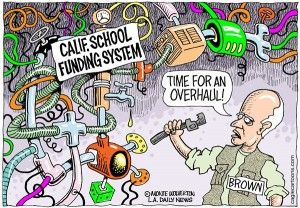Class warfare hits CA K-12 education
By Joseph Perkins
“Class warfare applied to schools.” That’s how pollster Dave Kanevsky describes the plan by Gov. Jerry Brown to change the way public school funding is allocated to divert money from the state’s middle-class and upper-income children to low-income children and English-language learners.
For the “centerpiece” of the governor’s education agenda, according to the Los Angeles Times, Brown proposes to give each of the state’s school districts a base grant, while also providing schools extra tax dollars for every poor or near-poor student in their classrooms, as well as every student less than fluent in English.
Kanevsky works for American Viewpoint, a Republican polling firm, which jointly conducts surveys with Greenberg Quinlan Rosner Research, a Democratic pollster. Together, the firms produce the USC Dornsife/Los Angeles Times poll, the latest of which was released last week.
Among its more noteworthy findings: That 50 percent of registered California voters support the idea of robbing from the state’s rich schools to give to poor (and disproportionately failing) schools.
While that poll number appears a positive to Brown, it really isn’t. That’s because the poll grossly oversampled Latino voters, the overwhelming majority of which favor the governor’s proposed redistribution of school funding.
Meanwhile, of whites that expressed an opinion of Brown’s plan, the majority were opposed. Typical was Debra Sexton, a 57-year-old Corona Democrat, who told the Times she thinks it unfair to take money from better schools. “I don’t think those schools should be punished because a lesser school isn’t making the grade,” she said.
Brown has unwittingly stumbled into war on two different fronts: class warfare, of which Kanevsky spoke in remarks to the Times. And racial warfare, as revealed by the decidedly differing views of whites and Latinos in the poll.
And if they were not potentially explosive enough, the centerpiece of the governor’s education agenda also places him at odds with both his fellow Democrats in the Legislature and the state’s powerful teachers unions, which are reflexively opposed to changing the formula by which schools are funded.
‘Unequals’
Yet Brown remains resolute. He thinks fairness demands that parents of middle- and upper-class children, attending the state’s high-performing schools, subsidize low-performing schools attended by the state’s low-income and non-English-speaking kids.
“It’s a classic case,” said Brown, speaking of his plan, “of justice to unequals.”
Well, it’s admirable, really, that Brown seeks justice for the state’s K-to-12 unequals. But his approach — diverting funds from the state’s middle-class and upper-income schools to the state’s lower-income schools — not only is divisive, it also won’t work.
That’s because it is based on the fallacious notion that if a school (or school district) has enough tax dollars to work with, it will turn out well-performing students.
Indeed, Washington, D.C. spends $29,409 per pupil, the highest in the country, according to the U.S. Census Bureau. Yet, it received an F grade for K-12 student achievement on its 2013 report card from Education Week.
Throwing good money after bad doesn’t make sense, whether we’re talking about public schools in the District of Columbia or California.
If Brown was really about justice to unequals, then he would empower parents of low-income or English-language-learning schoolchildren to exercise the same school choice as the state’s more affluent parents.
And the very best way to do that is with a K-12 low-income student assistance program that provides “scholarships” — vouchers — that can be used to enroll in public, private or parochial schools.
Related Articles
Gov. Brown shakes up CA Dems on preschool
California Democrats have been put back on their heels once again by Gov. Jerry Brown, whose approach to preschool education
Unions Say: 'Shut Up and Pay Us'
MAY 16, 2011 Yet another report confirms the enormous liabilities that California taxpayers must endure to pay for pensions for
A look at CA’s mixed-bag teacher firing reform
In some respects, it’s now easier to fire teachers in California. In others, it’s more complicated. That’s the verdict on





